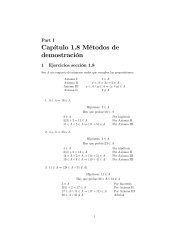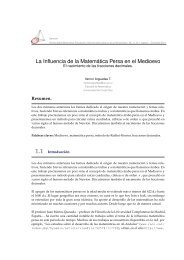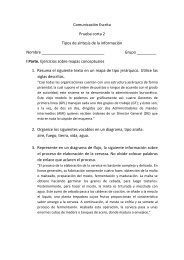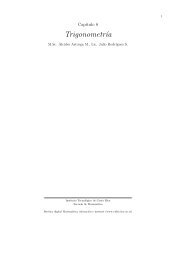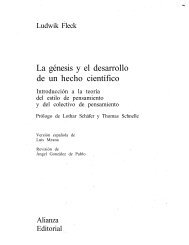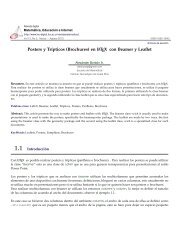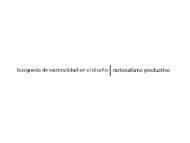Introducción a la teoría de números. Ejemplos y - TEC-Digital
Introducción a la teoría de números. Ejemplos y - TEC-Digital
Introducción a la teoría de números. Ejemplos y - TEC-Digital
Create successful ePaper yourself
Turn your PDF publications into a flip-book with our unique Google optimized e-Paper software.
si po<strong>de</strong>mos encontrar una constante C y x0 tal que<br />
f (x) ≤ Cg(x) cuando x > x0<br />
Para establecer esta <strong>de</strong>sigualdad, a menudo es muy útil usar el hecho <strong>de</strong> que si f es creciente,<br />
entonces a ≤ b cuando f (a) ≤ f (b). A veces se pue<strong>de</strong> usar <strong>la</strong> <strong>de</strong>rivada para establecer que f es<br />
creciente (o <strong>de</strong>creciente) en un intervalo.<br />
EJEMPLO 7.4<br />
Muestre que 3x 3 − x 2 + 1 ≪ x 3 conforme x → ∞<br />
Solución: Tenemos que encontrar C y x0 tal que x 3 − x 2 + 1 ≤ Cx 3 cuando x ≥ x0.<br />
Como 1 − x 2 < 0 si x > 1, entonces 3x 3 − x 2 + 1 < 3x 3 si x > 1. Por tanto basta tomar<br />
C = 3 y x0 = 1 para que se cump<strong>la</strong> <strong>la</strong> <strong>de</strong>finición.<br />
EJEMPLO 7.5<br />
Muestre que exp( � log(x)) ≪ x conforme x → ∞<br />
Solución: exp(x) y log(x) son funciones crecientes, entonces<br />
exp( � log(x)) ≤ x ⇐⇒ (tomando logaritmos)<br />
� log(x) ≤ log(x) ⇐⇒ (cuadrados a ambos <strong>la</strong>dos)<br />
log(x) ≤ log 2 (x), (∗)<br />
ahora, como u ≤ u 2 si u ≥ 1, <strong>la</strong> <strong>de</strong>sigualdad (∗) se cumple si x > e. Por tanto, basta tomar<br />
C = 1, y x0 = e para que se cump<strong>la</strong> <strong>la</strong> <strong>de</strong>finición.<br />
O gran<strong>de</strong> <strong>de</strong> Landau<br />
En general, nos interesa una manera <strong>de</strong> <strong>de</strong>cir que f y g son funciones parecidas en or<strong>de</strong>n<br />
excepto por un término <strong>de</strong> error dominado por una función h. Decimos que<br />
En particu<strong>la</strong>r, si g(x) ≡ 0,<br />
EJEMPLO 7.6<br />
f (x) = g(x) + O(h(x)) si | f (x) − g(x)| ≪ h(x)<br />
f (x) = O(h(x)) si f (x) ≪ h(x)<br />
Observe que f (x) = O(1) significa que f es una función acotada en un intervalo ]x0, ∞[.<br />
También, usando los dos ejemplos anteriores, 3x 3 − x 2 + 1 = O(3x 3 ) y exp( � log(x)) =<br />
O(x).<br />
113




